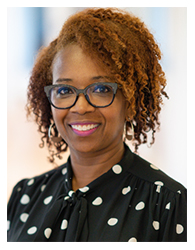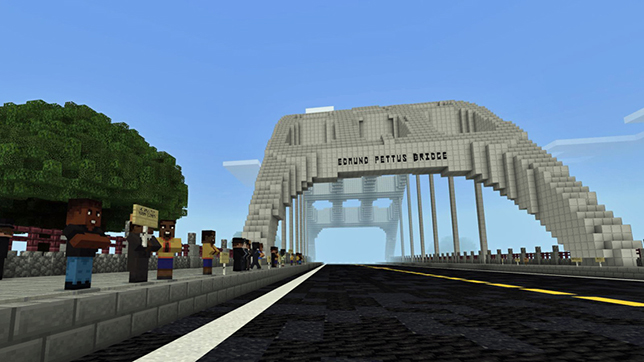How an Educator’s Persistence Led to a Student Leadership Initiative & the Most Popular Minecraft Edu Game of All Time
Felisa Ford's Student Ambassador Program in Atlanta Helped Transform the District; Her 'Good Trouble' Games Are Transforming the Way Students Learn About Social Justice
- By Kristal Kuykendall
- 07/20/22
Felisa Ford, co-creator of the most-downloaded educational game of all time, didn’t intend to be a “poster teacher” for game-based learning.
She’ll tell you she is not a “gamer.” She understands the skepticism of educators (and parents) when folks start talking about the gamification of education.
And even as she walks a journalist through the Minecraft: Education Edition lessons now integrated with Discovery Education’s learning platform, she — or the in-game character she is controlling — bumps and pauses, starts and restarts, clumsily moving through the opening scene in a M:EE world called The Mindful Knight. The game teaches kids about things like self-awareness, emotional regulation, and other SEL principles as they explore that world and learn about medieval Europe and the Middle Ages.
“Now, as you can see, I’m not a pro at Minecraft,” she says, laughing at her avatar’s apparent lack of coordination.
Ford, illustrating how the game works, points her avatar in the direction of a Queen, called a non-player character — these NPCs are programmable in the Education Edition but not in the original Minecraft game — and explains that NPCs give the players challenges to solve as well as hints and instructions to help them along the way.
She bumps into another table before she gets to the Queen. Ford’s player is reminiscent of Atari-era graphics and looks like a cartoon “person” built out of little blocks. The entirety of Minecraft looks like that, actually.
Ford laughs again.
“Oops, sorry! I am trying to find out where I need to go here, to get my first challenge. This is honestly what a real teacher brand new to the game would go through…”
 Ford is no rookie when it comes to Minecraft: Education Edition, though.
Ford is no rookie when it comes to Minecraft: Education Edition, though.
Although she doesn’t play video games as a front-end user much, last year Ford co-created a new M:EE “world,” which is an immersive experience with a particular theme or subject area, its own custom landscape and characters, and curriculum-aligned lessons embedded throughout as part of each player’s game challenges.
Ford’s world, called “Lessons in Good Trouble,” is the most downloaded world in Minecraft’s history. Not just in Minecraft: Education Edition’s history. In all of Minecraft’s history.
To add context: Minecraft, launched in 2011, is the best-selling video game of all time, with more than 238 million copies sold; Minecraft: Education Edition, launched in 2016, has about 35 million licensed school users across 115 countries, Microsoft told THE Journal. M:EE is free to Microsoft Education users.
How a Slow Starter Became a Districtwide Hit – and Beyond
Ford, who became a digital learning specialist in 2015 after two decades as a Social Studies teacher in Atlanta Public Schools, had completed certifications as a Microsoft Innovative Educator and a Global Minecraft Mentor prior to the beginning of the pandemic. She’d seen the potential of Minecraft to capture students’ imaginations and engage them in learning every kind of subject; M:EE worlds are built around standards-aligned lessons for every grade level across subjects ranging from science, math, computer science, and coding to language arts, history, SEL, climate and sustainability, and art and design.
But Minecraft was “slow to take off” with teachers in Atlanta Public Schools, even after the district’s instructional technology team had conducted several 1- and 2-day Minecraft training sessions with teachers in 2018 and 2019, Ford said.
Brainstorming ensued. How could they get teachers — typically wary of giving up classroom instruction time to video games — to try out Minecraft: Education Edition in their classrooms?
“We knew that if the teachers just introduced the Minecraft platform to their class, the students would take it and run with it,” Ford explained in a guest post on Microsoft’s M:EE blog. “That’s when the light clicked for us: We would flip our Minecraft professional learning on its head and let the students be the leaders and train the teachers, and the APS Minecraft Student Ambassadors Program as we know it was born! We wanted to make sure that this program gave students — the true Minecraft experts — the opportunity to be the student leaders they wanted to be.”
So Ford and her Minecraft-trained colleagues at APS started up the first-ever Minecraft Student Ambassador Program; the ambassadors’ mission would be to serve as a “Minecraft expert in their class or school and be willing to support, assist, or mentor other students and teachers with using the program,” she explained.
And — as you might have guessed by now, since her blog about it was featured by Microsoft — the student ambassador program was wildly successful at putting teachers at ease about introducing M:EE in their classes, and at showing teachers how enthusiastically students engaged with learning through Minecraft, Ford said. Two years later, M:EE is used in every subject area at every grade level in the Atlanta district.
“We now have parents, students, and teachers constantly inquiring about participating in our next (Minecraft Student Ambassador Program),” she said. “Making these ambassadors visible in the district and allowing them to function as the Minecraft experts in their school has helped us champion the platform in more ways than we could have ever imagined.”
Microsoft took note of the Atlanta ambassador program’s success and launched its own global Minecraft Student Ambassador Sponsor Program, an educator learning path that prepares teachers, administrators, and instructional technologists for starting a student ambassador program in their own schools.
Ford said that near the start of the pandemic, every student in grades 6–8 received a device with M:EE already installed, “and we saw an increase in our overall middle school performance on the state standardized test in both literacy and math” — a localized example of a host of academic research showing that Minecraft used in teaching improves student achievement and instills social-emotional skills that students missed out on during COVID shutdowns.
One such study conducted by Canadian researchers in third- through sixth-grade classrooms concluded that “Minecraft can not only help students develop problem-solving and teamwork skills, it can increase their motivation as well … and has been shown to stimulate students’ interest in science and ... learn about technology, teamwork, and engineering,” the research report said. “So, besides exercising their creativity, users can inhabit a virtual environment to learn about and use concepts that are more difficult to understand in real life.”
Becoming Widely Known for Good Trouble
As a constituent of the late civil rights activist Congressman John Lewis and a political science major in college, Ford had long been a follower of Lewis; when she was teaching Social Studies, she took her students on a field trip every year on the Bloody Sunday anniversary to Selma, Ala., where they’d hear Rep. Lewis speak about the historic events that happened there and his ongoing advocacy for civil rights and social justice.
In late spring 2020, days after the killing of George Floyd sparked Black Lives Matter protests across the country, Ford got an email from the Minecraft: Education Edition team, inviting her to help figure out a way to explain what was happening to students.
Ford and two colleagues, Natasha Rachell and Ken Shelton, met the moment.
They began developing the standards-aligned materials and content for a whole new collection of Minecraft games that would eventually be named “Lessons in Good Trouble”; Microsoft’s gaming division, Mojang Studios, provided help from its developers to turn their content into an interactive Minecraft world. The collection “aims to cultivate a strong understanding of inclusion, equity, and community as your learners develop skills in Citizenship, Critical Thinking, and Community Building,” according to the Microsoft blog announcing the Good Trouble launch.
The first game in the collection, also named Lessons in Good Trouble, features a non-player character representing Lewis himself, and he walks the student-player’s avatar through his own historic experiences and through the stories of other leaders of social justice movements around the world as they get in “good trouble” and impact positive change.

Educator resources for this and every M:EE game include such things as a list of learning objectives, guiding ideas and discussion questions, specific teacher preparation recommendations, suggestions for differentiating learning for students with a variety of needs and abilities, downloadable full lesson plans, recommended student activities, and links to external reference sites related to the game’s content, which in this case includes the National Museum of African American History and Culture, and the Smithsonian Institute’s social justice movement collections.
Subsequent games in the Good Trouble collection focus on the Black Lives Matter movement, the U.S. civil rights movement, Dr. Martin Luther King Jr., the characteristics of identity, the women’s suffrage movement, Ghandi and the India independence movement, Nobel Peace Prize winner Malala Yousafzai and her fight for girls’ education in Pakistan, and the history of Apartheid in South Africa.
Since the first Good Trouble lesson launched at the end of 2021, it has been downloaded more than 3.5 million times — more than any other Minecraft game — and Ford has become somewhat of a celebrity for her efforts. She’s been featured in several Georgia magazines and regional media outlets, and she was recently named to TIME’s Innovative Teachers 2022 list.
Ford told THE Journal that she simply wanted to empower students while teaching them about history and the context of current societal upheaval — and do so in a manner that helps them love to learn.
“We want all students to know the stories of the activists all over the world who've gotten into Good Trouble standing up for the rights of others, and now they learn all that while they’re playing a game and problem-solving and even learning to code in Minecraft,” she said. “The platform almost entices educators and students to make their learning and gaming bigger than Minecraft — we all want students to be able to apply in the real world some of the things they have learned in this Minecraft world. That's exactly what Minecraft: Education Edition does.”